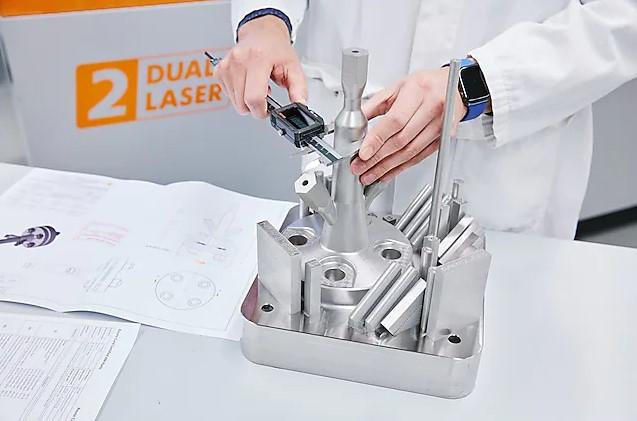- FMA
- The Fabricator
- FABTECH
- Canadian Metalworking
Our Publications
Categories
- Additive Manufacturing
- Aluminum Welding
- Arc Welding
- Assembly and Joining
- Automation and Robotics
- Bending and Forming
- Consumables
- Cutting and Weld Prep
- Electric Vehicles
- En Español
- Finishing
- Hydroforming
- Laser Cutting
- Laser Welding
- Machining
- Manufacturing Software
- Materials Handling
- Metals/Materials
- Oxyfuel Cutting
- Plasma Cutting
- Power Tools
- Punching and Other Holemaking
- Roll Forming
- Safety
- Sawing
- Shearing
- Shop Management
- Testing and Measuring
- Tube and Pipe Fabrication
- Tube and Pipe Production
- Waterjet Cutting
Industry Directory
Webcasts
Podcasts
FAB 40
Advertise
Subscribe
Account Login
Search
Shell plans digital future for spare-parts production and management
Shell works to expand 3D printing’s use in the energy sector
- July 20, 2021
- Article
- Additive Manufacturing

Shell has committed to establishing an AM program that will allow it to warehouse and 3D-print digital designs of its spare parts. Shell
A report posted to the Shell website provides an overview of the global energy company’s strategy for adopting additive manufacturing to transform how it produces spare parts.
The authors—Shell’s supply chain digitalization manager, Nick van Keulen, and 3D printing technology manager, Angeline Goh—maintain that 3D printing will reduce the company’s costs to make spare parts, shorten delivery times, and shrink its carbon footprint.
“We are collaborating with industry leaders to push the innovation of 3D printing for the energy sector,” they wrote.
10 Years of AM
Shell’s 3D printing journey began in 2011, when it acquired a metal laser printer to fabricate unique testing equipment for laboratory experiments at the Shell Technology Center Amsterdam (STCA). Today, Shell has about 15 polymer, ceramic, and metal printers located at its technology centers in Amsterdam and Bangalore, India.
Although Shell is capable of 3D-printing spare parts, it has chosen to collaborate with OEMs qualified to supply the components. When an OEM is not available, Shell will reverse-engineer the part—in compliance with intellectual property laws—and have a commercial supplier print it from a 3D model. In emergency cases and when IP is not an issue, Shell will print spare parts in-house.
Shell’s 3D printing strategy is to develop a digital warehouse that stocks all the information required to additively manufacture components when they are needed, in partnership with OEMs and local partners.
A digital warehouse supplemented by local ecosystems “offers true lead-time reduction, responsible use of resources, and progress for the local communities where Shell operates,” wrote van Keulen and Goh.
Success Story
An example of the program’s benefits occurred earlier this year, when Shell and U.K.-based turbomachinery builder Elliott Group successfully 3D-printed an aluminum alloy impeller for a multistage, high-pressure liquified natural gas pump. The teams worked together to establish the technical specifications of the part—used for cryogenic hydrocarbon service—and qualify the printing process.
The actual printing of the impeller, heat treatment, and testing were completed within 40 days, which is 85% less than the normal delivery time for such parts. In addition to the time savings, the 3D-printed impeller exhibits better mechanical performances compared to traditionally cast impellers.
“Working together with Shell, both organizations learned valuable lessons, confirming the significant advantages of 3D printing: precision manufacturing, lead-time reduction, and a higher quality component,” said Elliott’s manager of material engineering, Derrick Bauer.
Shell’s approach to 3D printing reduces the need to purchase, hold, and maintain a large inventory of spare parts, as well as assists with developing novel part designs and prototyping. Furthermore, printing close to the destination asset reduces the emissions associated with transporting parts. It also helps create shorter and more effective supply chains supported by highly skilled local workers.
“The recent success confirmed our willingness to develop digital warehouses in the energy industry,” according to van Keulen and Goh. They added that 3D printing is becoming an established manufacturing technique in other industries, such as aerospace, automotive, and medical, yet the energy industry is slow on the uptake. One of the main reasons is the lack of commonly accepted technical standards within the industry. Resolving this means cooperation across the whole supply chain, from end users to assurance providers to specialized print shops and OEMs.”
Click here to read the full report.
About the Publication
- Podcasting
- Podcast:
- The Fabricator Podcast
- Published:
- 04/16/2024
- Running Time:
- 63:29
In this episode of The Fabricator Podcast, Caleb Chamberlain, co-founder and CEO of OSH Cut, discusses his company’s...
- Trending Articles
- Industry Events
16th Annual Safety Conference
- April 30 - May 1, 2024
- Elgin,
Pipe and Tube Conference
- May 21 - 22, 2024
- Omaha, NE
World-Class Roll Forming Workshop
- June 5 - 6, 2024
- Louisville, KY
Advanced Laser Application Workshop
- June 25 - 27, 2024
- Novi, MI




























